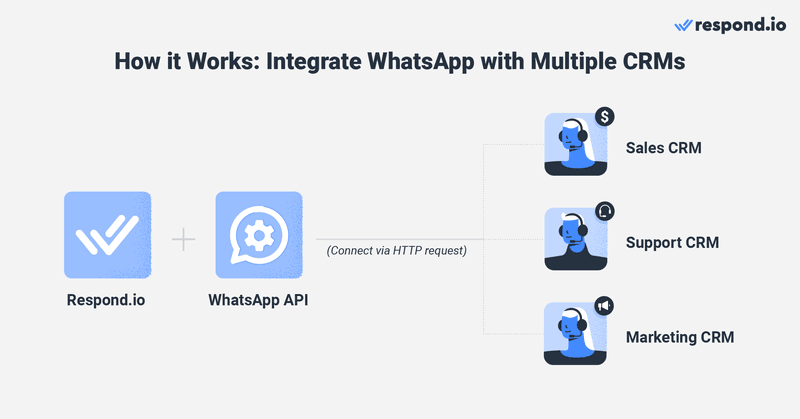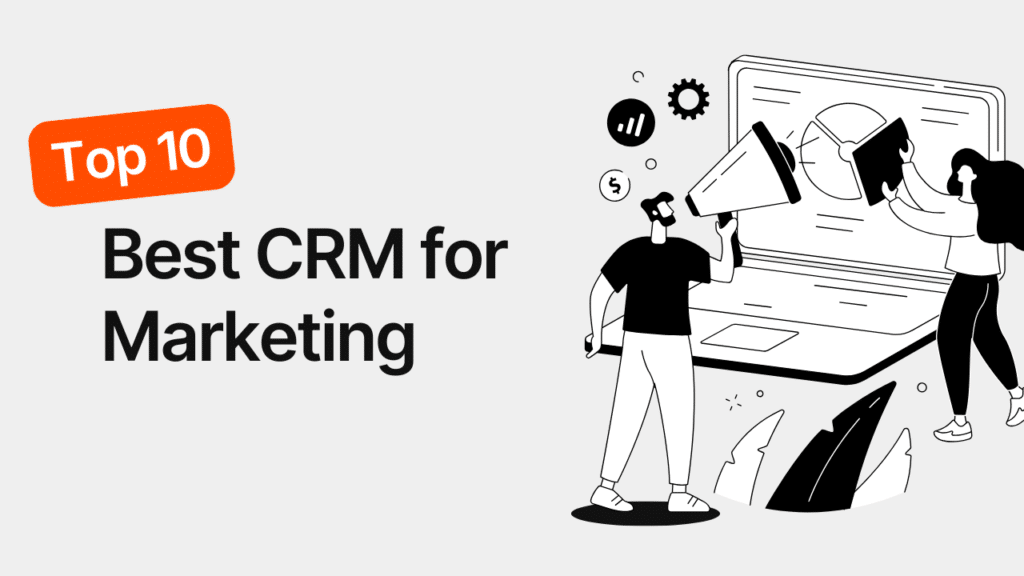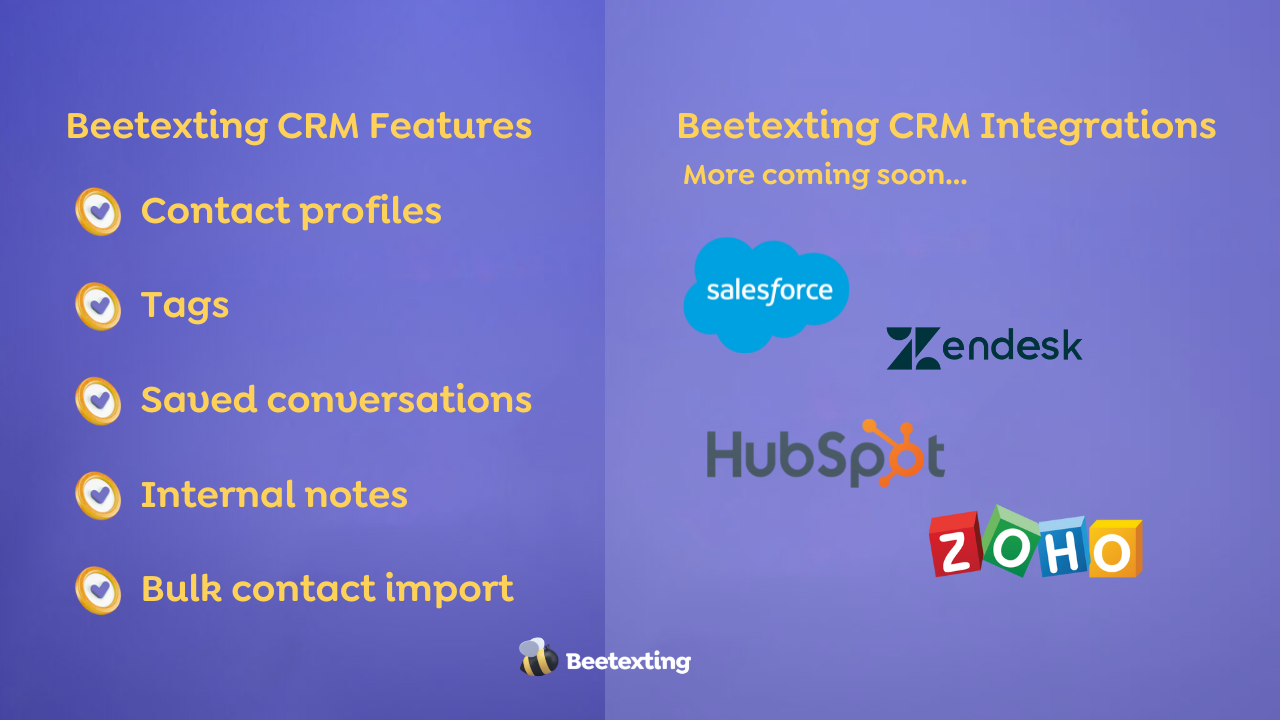
Supercharge Your Sales: CRM Integration with WhatsApp – A Complete Guide
In today’s fast-paced business environment, staying connected with your customers is more critical than ever. And what’s the most ubiquitous communication tool globally? WhatsApp, of course! With billions of users, WhatsApp has become the go-to platform for instant messaging, making it an invaluable tool for businesses. But simply using WhatsApp for customer interactions isn’t enough. To truly harness its power, you need to integrate it with your Customer Relationship Management (CRM) system. This comprehensive guide will delve into the world of CRM integration with WhatsApp, explaining its benefits, how to implement it, and the best practices to ensure success.
Why CRM Integration with WhatsApp is a Game Changer
Let’s face it, managing customer relationships can be a complex undertaking. You’re juggling multiple communication channels, tracking interactions, and trying to personalize every interaction. Without a robust system, things can quickly become overwhelming. This is where CRM integration with WhatsApp steps in. It’s not just a tech upgrade; it’s a fundamental shift in how you interact with your customers, streamlining your processes and boosting your bottom line.
Seamless Communication, Enhanced Efficiency
Imagine this: a customer messages you on WhatsApp with a query. With integrated systems, that message instantly appears in your CRM, along with the customer’s profile, purchase history, and any previous interactions. Your sales or support team can immediately access all the information they need, providing a quick and personalized response. No more switching between apps, manually entering data, or losing track of conversations. This seamless communication leads to enhanced efficiency, allowing your team to handle more customer interactions with ease.
Personalized Customer Experiences
Personalization is the name of the game in today’s market. Customers crave experiences tailored to their individual needs and preferences. CRM integration with WhatsApp allows you to deliver just that. By having all the customer data at your fingertips, you can craft personalized messages, offer relevant product recommendations, and provide proactive support. This level of personalization fosters stronger customer relationships and increases loyalty.
Improved Sales Performance
Integrating WhatsApp with your CRM can significantly boost your sales performance. Sales representatives can use WhatsApp to nurture leads, send promotional offers, and close deals directly through the platform. The ability to communicate in real-time, share rich media like images and videos, and provide instant support can dramatically accelerate the sales cycle. Moreover, you can track the success of your WhatsApp campaigns within your CRM, providing valuable insights into what’s working and what’s not.
Better Customer Support
Customer support is a critical aspect of any business. WhatsApp integration allows you to provide instant and convenient support to your customers. They can reach out with their queries, track their orders, and get assistance in real-time. This reduces wait times, improves customer satisfaction, and builds a positive brand image. Moreover, you can automate some support tasks using chatbots, freeing up your support team to handle more complex issues.
Data-Driven Insights
CRM systems are designed to gather and analyze data. When integrated with WhatsApp, you gain valuable insights into your customer interactions. You can track metrics like response times, conversation lengths, and customer satisfaction scores. This data can be used to optimize your communication strategies, identify areas for improvement, and make data-driven decisions to enhance your customer relationships.
Key Features of CRM Integration with WhatsApp
The specific features available through CRM integration with WhatsApp will vary depending on the CRM and integration platform you choose. However, some common and essential features include:
- Two-Way Messaging: The ability to send and receive messages directly within your CRM.
- Contact Synchronization: Automatic syncing of WhatsApp contacts with your CRM database.
- Conversation History: Storing all WhatsApp conversations within the customer’s CRM profile.
- Automated Workflows: Triggering automated actions based on WhatsApp interactions, such as sending follow-up messages or updating customer records.
- Chatbots: Integrating chatbots to provide instant support, answer frequently asked questions, and qualify leads.
- Reporting and Analytics: Tracking key metrics like response times, conversation volumes, and customer satisfaction.
- Multimedia Support: Sending and receiving images, videos, documents, and other media files.
- Template Messages: Utilizing pre-written message templates for faster and more consistent communication.
How to Integrate WhatsApp with Your CRM: A Step-by-Step Guide
Integrating WhatsApp with your CRM may seem daunting, but it’s a manageable process with the right approach. Here’s a step-by-step guide to help you get started:
1. Choose a CRM and WhatsApp Integration Platform
The first step is to select a CRM system that meets your business needs. Popular choices include Salesforce, HubSpot, Zoho CRM, and many others. Once you’ve chosen your CRM, you’ll need to find a WhatsApp integration platform that is compatible with your chosen CRM. Several platforms specialize in integrating WhatsApp with CRM systems, such as Twilio, MessageBird, and WATI. Research and compare different platforms to find the one that best fits your requirements and budget.
2. Set Up Your WhatsApp Business Account
If you haven’t already, you’ll need to set up a WhatsApp Business account. This is essential for using WhatsApp for business purposes. You can either use the WhatsApp Business app (for small businesses) or the WhatsApp Business API (for larger businesses). The WhatsApp Business API offers more advanced features and integration capabilities.
3. Obtain Your WhatsApp Business API Access (if applicable)
If you’re using the WhatsApp Business API, you’ll need to apply for access. This involves submitting your business information and agreeing to WhatsApp’s terms of service. The approval process can take some time, so plan accordingly.
4. Connect Your CRM to the Integration Platform
Once you’ve chosen your integration platform, you’ll need to connect it to your CRM. This typically involves entering your CRM credentials and following the platform’s instructions. The process varies depending on the platform and CRM, but it usually involves authenticating your account and granting the platform access to your CRM data.
5. Configure Your WhatsApp Integration
The next step is to configure your WhatsApp integration within the integration platform. This includes setting up your WhatsApp phone number, defining your messaging templates, and configuring any automated workflows you want to use. You can also customize the integration to match your branding and communication style.
6. Test Your Integration
Before going live, it’s crucial to test your integration thoroughly. Send test messages, check that customer data is syncing correctly, and ensure that all features are working as expected. This will help you identify and resolve any issues before they impact your customers.
7. Train Your Team
Once your integration is set up and tested, train your team on how to use it effectively. Show them how to send and receive messages, access customer data, and use any automated workflows. Provide them with clear guidelines and best practices for communicating with customers on WhatsApp.
8. Monitor and Optimize
After launching your integration, monitor its performance and make adjustments as needed. Track key metrics, gather feedback from your team, and continuously optimize your workflows to improve efficiency and customer satisfaction.
Best Practices for CRM Integration with WhatsApp
To maximize the benefits of CRM integration with WhatsApp, it’s essential to follow these best practices:
1. Prioritize Customer Privacy and Data Security
Always prioritize customer privacy and data security. Ensure that you comply with all relevant data privacy regulations, such as GDPR and CCPA. Use secure messaging practices and protect customer data from unauthorized access. Be transparent with your customers about how you’re using their data and obtain their consent when necessary.
2. Personalize Your Messaging
Leverage the customer data in your CRM to personalize your WhatsApp messages. Address customers by name, reference their purchase history, and offer tailored recommendations. Personalized messages show that you value your customers and understand their needs.
3. Respond Promptly
WhatsApp is an instant messaging platform, so customers expect quick responses. Aim to respond to messages within a reasonable timeframe, ideally within a few minutes. This demonstrates that you’re attentive to your customers’ needs and value their time.
4. Use Clear and Concise Language
Keep your messages clear, concise, and easy to understand. Avoid using jargon or technical terms that your customers may not be familiar with. Get straight to the point and provide the information they need in a timely manner.
5. Utilize Rich Media
WhatsApp supports rich media, such as images, videos, and documents. Use these features to enhance your messages and provide a more engaging experience. Share product photos, instructional videos, or helpful documents to provide valuable information to your customers.
6. Segment Your Audience
Segment your audience based on their demographics, purchase history, or other relevant criteria. This allows you to send targeted messages that are more likely to resonate with each segment. For example, you can send special offers to customers who have purchased a particular product or send birthday greetings to your loyal customers.
7. Automate Where Appropriate
Use automation to streamline your communication processes. Set up automated welcome messages, order confirmations, and follow-up messages. Automating these tasks can save you time and effort while ensuring that your customers receive timely and consistent communication.
8. Track and Analyze Your Results
Track key metrics, such as response times, conversation volumes, and customer satisfaction scores. Analyze this data to identify areas for improvement and optimize your communication strategies. Use the insights you gain to make data-driven decisions and continuously improve your customer relationships.
9. Adhere to WhatsApp’s Business Policies
Familiarize yourself with WhatsApp’s business policies and adhere to them. These policies outline the types of messages you can send, the content you can share, and the ways you can use the platform. Violating these policies can result in your account being suspended, so it’s essential to stay compliant.
10. Provide Excellent Customer Service
Ultimately, the success of your CRM integration with WhatsApp depends on the quality of your customer service. Train your team to be friendly, helpful, and responsive to customer inquiries. Go the extra mile to exceed customer expectations and build strong, lasting relationships.
Choosing the Right WhatsApp CRM Integration Platform
Selecting the perfect platform to meld WhatsApp with your CRM is crucial. Here’s what to consider:
1. Compatibility with Your CRM
First and foremost, ensure the platform works seamlessly with your existing CRM. Check for native integrations or APIs that allow for smooth data exchange. Compatibility is non-negotiable.
2. Features and Functionality
Assess the features offered. Does it support two-way messaging, contact synchronization, and automated workflows? Does it offer reporting and analytics to track your performance? The more features that align with your needs, the better.
3. Scalability
Consider the potential for growth. Can the platform handle increasing volumes of messages and users as your business expands? Choose a platform that can scale with your evolving requirements.
4. Security
Data security is paramount. Ensure the platform employs robust security measures to protect customer data and comply with privacy regulations like GDPR and CCPA.
5. User-Friendliness
A user-friendly interface simplifies the integration process and makes it easier for your team to adopt the new system. Look for a platform with intuitive navigation and clear instructions.
6. Pricing
Compare pricing models from different platforms. Consider the features included, the number of users supported, and the messaging volume. Choose a plan that aligns with your budget and needs.
7. Support and Training
Check the level of support and training provided. Do they offer documentation, tutorials, and customer support to assist you with setup and troubleshooting? Reliable support is a valuable asset.
Common Challenges and How to Overcome Them
While CRM integration with WhatsApp offers numerous benefits, it’s essential to be aware of potential challenges and how to address them:
1. Data Synchronization Issues
One common challenge is ensuring that customer data is synchronized correctly between your CRM and WhatsApp. To overcome this, choose a platform with robust data synchronization capabilities and regularly check for any discrepancies. Implement processes to resolve data inconsistencies promptly.
2. Technical Difficulties
Technical glitches can sometimes occur during integration. To minimize this, select a platform with reliable technical support. Thoroughly test the integration before launch and have a plan for addressing any technical issues that may arise.
3. Training and Adoption
Ensuring that your team is properly trained and adopts the new system can be challenging. Provide comprehensive training sessions and ongoing support to help your team understand how to use the integration effectively. Encourage feedback and address any concerns they may have.
4. Compliance and Privacy
Complying with data privacy regulations, such as GDPR and CCPA, is crucial. Ensure that the platform you choose complies with these regulations and implement strict data privacy practices. Obtain customer consent before using their data and be transparent about how you’re using it.
5. Managing High Volumes of Messages
As your business grows, you may experience a high volume of messages. To manage this, implement automation to handle repetitive tasks. Consider using chatbots to answer frequently asked questions and provide instant support. Ensure that your team has the resources to handle the volume of messages efficiently.
The Future of CRM and WhatsApp Integration
The integration of CRM systems with WhatsApp is an evolving landscape, and the future looks incredibly promising. Here are some trends and predictions:
1. Advanced AI and Chatbots
Expect to see more sophisticated AI-powered chatbots that can handle complex customer interactions, provide personalized recommendations, and even assist with sales and support tasks. These chatbots will become increasingly intelligent and capable of understanding natural language.
2. Enhanced Personalization
CRM and WhatsApp integrations will become even more personalized, leveraging customer data to create highly tailored experiences. Businesses will be able to anticipate customer needs and proactively offer relevant products and services.
3. Deeper Integration with Other Channels
We’ll see deeper integration with other communication channels, such as email, SMS, and social media. This will enable businesses to provide a unified customer experience across all channels.
4. Increased Automation
Automation will continue to play a significant role, with more tasks being automated to streamline workflows and improve efficiency. This includes automated message sending, data entry, and reporting.
5. More Robust Analytics
Businesses will have access to more robust analytics, providing deeper insights into customer behavior and the effectiveness of their communication strategies. This data will be used to optimize customer interactions and improve business outcomes.
Conclusion: Embrace the Power of CRM Integration with WhatsApp
CRM integration with WhatsApp is no longer a luxury; it’s a necessity for businesses that want to thrive in today’s competitive market. By seamlessly connecting these two powerful platforms, you can enhance customer relationships, improve sales performance, and drive business growth. Follow the best practices outlined in this guide, choose the right integration platform, and embrace the future of customer communication. Your customers will thank you for it, and your bottom line will reflect the positive impact.


